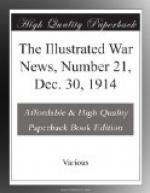_______________________________________________________
___________________ 38—THE ILLUSTRATED WAR NEWS, DEC. 30, 1914.—[Part 21]
[Illustration: SHIPS THE BRITISH NAVY MIGHT HAVE HAD! FREAKS OF MARINE ARCHITECTURE THAT HAVE NOT BEEN OFFICIALLY ADOPTED.]
We illustrate here and on the page opposite some curious designs for war-ships by various inventors. No. 1 is McDougal’s Armoured Whale-back, with conning-towers, a design of 1892 for converting whalebacks into war-vessels. No. 2 is an American design of 1892, Commodore Folger’s Dynamite Ram, cigar-shaped, with two guns throwing masses of dynamite or aerial torpedoes. No. 3 is a design by the Earl of Mayo in 1894 and called “Aries the Ram,” built round an immense beam of steel terminating in a sharp point, No. 4 is Gathmann’s boat for a heavy gun forward, designed in 1900. She was to be of great speed, and the forward gun was to throw 600 lb. of gun-cotton at the rate of 2000 feet per second. A formidable Armada this, had it been practicable.
_______________________________________________________
___________________ THE ILLUSTRATED WAR NEWS, DEC. 30, 1914—[Part 21]—39
[Illustration: SHIPS THE BRITISH, AND THE GERMAN, NAVY MIGHT HAVE HAD! DESIGNS BY THE KAISER AND OTHER NAVAL THEORISTS.]
The first illustration on this page is a design for a battle-ship made by the Kaiser in 1893, to replace the old “Preussen,” then out of date. The vessel was to carry four large barbettes and a huge umbrella-like fighting-top. Illustration No. 2 is an Immersible Ironclad, designed by a French engineer named Le Grand, in 1862. In action the vessel was to be partly submerged, so that only her three turrets and the top of the armoured glacis would be visible. No. 3 is Admiral Elliott’s “Ram,” of 1884. The ship was to carry a “crinoline” of stanchions along her water-line, practically a fixed torpedo-net. No. 4 is Thomas Cornish’s Invulnerable Ironclad, of 1885. She was to have two separate parallel hulls under water; above she was of turtle-back shape.
_______________________________________________________
___________________ 40—THE ILLUSTRATED WAR NEWS, DEC. 30, 1914.—[Part 21]
[Illustration: EXPERTS IN CLOSE-QUARTER FIGHTING: SIBERIAN INFANTRYMEN IN THEIR FIELD-SERVICE EQUIPMENT AT WARSAW.]
Our illustration shows a halt in one of the squares of Warsaw of one of the regiments of Siberian infantry, whose magnificent fighting qualities in all the battles of the war in the eastern theatre of operations in which they have taken part have gained for them, as the accounts of the different actions sent to London from Petrograd testify, the outspoken admiration of the whole Russian Army. Particularly singled out for praise has been their audacious expertness in close-quarter combats. They supply both infantry and artillery, and are recruited all over Siberia, forming ordinarily two separate commands, the East Siberian and the West Siberian troops, which garrison the fortresses and districts between Vladisvostock and the Ural Mountains, the dividing range between European and Asiatic Russia.




